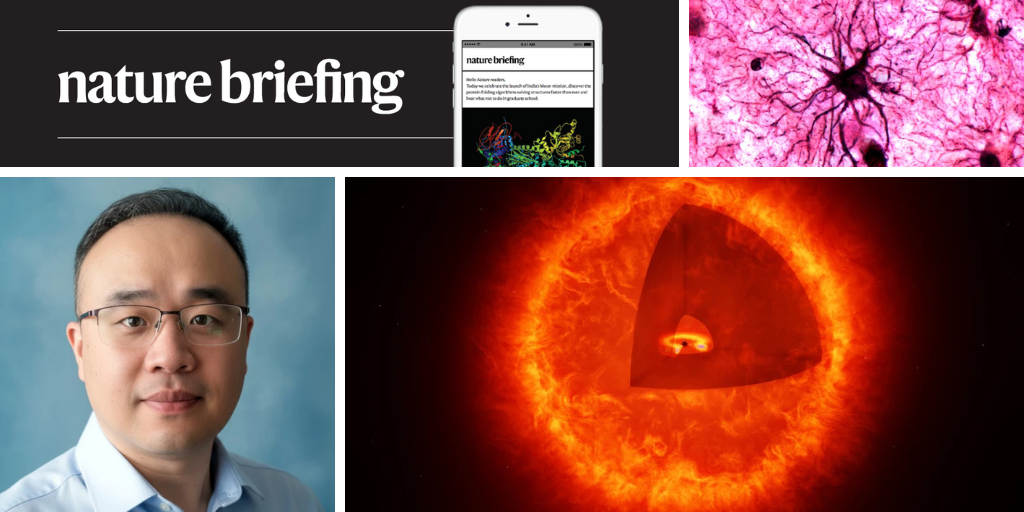You have full access to this article via your institution.
Hello Nature readers, would you like to get this Briefing in your inbox free every day? Sign up here.

A type of brain cell called astrocytes play a crucial role in stabilizing memories in the brain.Credit: Jose Calvo/SPL
Astrocytes — brain cells once thought of as supporting players to neurons — have a principal role in stabilizing memories for long-term recall. In mice, researchers found that Fos, a gene associated with cell activity, was highly expressed in the astrocytes of mice that re-entered cages they’d been conditioned to associate with fear. The team also found that highly-active astrocytes produce more receptors that respond to the neurotransmitter noradrenaline, which allows them to communicate with neurons. The findings indicate that, along with neurons, astrocytes are actively involved in creating physical traces of memories in the brain.
The mysterious ‘little red dots’ (LRDs) seen in images of the early universe captured by the James Webb Space Telescope are probably a brand-new type of celestial object, astronomers have tentatively agreed. Researchers now believe these ‘rubies’ to be a hybrid of a black hole and a star: an active black hole wrapped in a cocoon of hot, dense gas that glows as the black hole warms it. Armed with this theory, astronomers are turning to figuring out how LRDs form, how they evolve and whether they still exist in the modern universe.
The evolution of poison-secreting glands helped toads thrive and spread to almost every continent. An analysis of the DNA of 124 toad species allowed researchers to map the amphibian’s evolutionary history. Their findings reveal that toads originated in South America and first spread to Africa, possibly via Antarctica or by rafting directly across the sea. Just after this initial spread, the number and diversity of toad species boomed. At the same time, they evolved glands that secrete potent toxins. This “antipredator strategy” would have given toads “a tremendous edge over other amphibians”, says herpetologist Christopher Raxworthy.
Reference: Proceedings of the Royal Society B paper
Features & opinion
At first, the rise of agentic artificial intelligence (AI) — large language models that carry out multi-step tasks by connecting to external tools — gave bioinformatician Lei Zhu pause. He wondered whether such models would make trained bioinformaticians redundant. But during a study of cancer gene-expression, his answer became clear: AI hasn’t diminished his role, but has redefined it. Now, he sees his role as a supervisory one, and offers tips for those facing a similar situation. “Embrace the technology,” he says. “Not to replace your expertise, but to amplify it.”
Most people have a least-favourite sound — I hate a ticking clock — but in extreme cases, this loathing is characterized as misophonia, which can cause extreme distress. Now evidence suggests that misophonia is correlated with a lack of ‘affective flexibility’ — the ability to switch focus between emotional and non-emotional information — and a tendency to get stuck in negative thought patterns. It’s not known how misophonia is linked to these cognitive factors, but the finding could be a step toward better diagnosis. “These findings highlight just how complex our experiences with sound can be,” writes cognitive neuroscientist Helen Nuttall. “Hearing really is much more than just the ear doing its job.”
Reference: British Journal of Psychology paper
Mycoheterotrophic plants don’t rely on photosynthesis — instead, they partner with fungi in the soil to feed themselves. Biologist Kenji Suetsugu has dedicated his career to studying these pale ‘ghost flowers’, resulting in some 250 papers since 2008 (plus an upcoming children’s book). Gaze at a stunning gallery of images of the pale, translucent plants while catching up with the many wonders that Suetsugu has discovered about them.
Infographic of the week

Is it a bird, is it a plane? If the question is ‘what is the most efficient form of locomotion’, the answer is: a person on a bicycle. For Scientific American’s 180th birthday, the magazine has updated a classic graphic comparing different forms of animal and motorized locomotion, first published in 1973. Bicycles “turn humans into this hyperefficient terrestrial locomotor because they make being on land more like swimming,” says comparative physiologist Tyson Hedrick. (Scientific American | 4 min read) (DTAN Studio)
Today I’m looking forward to what I think will be my new favourite channel: Space Live. The channel, hosted by UK network ITV, treats viewers to a live feed of the Earth as seen from the International Space Station all day every day. Broadcast in 4K and accompanied by soothing music, the channel is like ASMR for astrophiles.
There’s just one downside: a continuous stream of Earth does get a tad repetitive. Maybe time to change the channel; I think I’ve seen this one before.
Whatever channel I’m watching, I’ve got an eye on our inbox. Should you have any feedback on this newsletter, please send it to [email protected].
Thanks for reading,
Jacob Smith, associate editor, Nature Briefing
With contributions by Flora Graham
• Nature Briefing: Careers — insights, advice and award-winning journalism to help you optimize your working life
• Nature Briefing: Microbiology — the most abundant living entities on our planet — microorganisms — and the role they play in health, the environment and food systems
• Nature Briefing: Anthropocene — climate change, biodiversity, sustainability and geoengineering
• Nature Briefing: AI & Robotics — 100% written by humans, of course
• Nature Briefing: Cancer — a weekly newsletter written with cancer researchers in mind
• Nature Briefing: Translational Research — covers biotechnology, drug discovery and pharma


